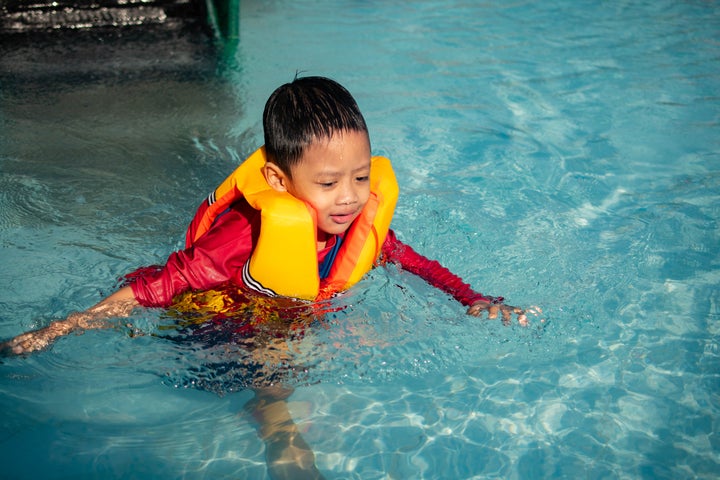🔴 Website 👉 https://u-s-news.com/
Telegram 👉 https://t.me/usnewscom_channel
For kids between the ages of 5 and 14, drowning is the second-leading cause of unintentional death, the Centers for Disease Control and Prevention reports.
That’s why a life jacket is one of the most important items your child can wear in the water this summer — but too many adults are unaware of what type of jackets they should be getting for kids, if they remember one at all.
Kourtney Kardashian recently found this out the hard way. The social media star got called out online for photographing her 21-month-old son, Rocky, without a life jacket on a boat. “Update: bought a life vest that fits!” she shared later in an Instagram Story. “Honestly didn’t think about some of the dangers.”
We don’t know exactly which life jacket Kardashian ended up getting for her son, but it can mean the difference between a life jacket that works and one that is effectively useless.
Not all life jackets are created equally. In fact, some flotation devices, such as “swim vests” or “floaties,” are not U.S. Coast Guard-approved life jackets, which get tested for buoyancy and performance.
“There’s no regulations for how people market these things,” said B. Chris Brewster, chair of the national certification committee for the United States Lifesaving Association and a former lifeguard chief in San Diego.
“Once you get away from a U.S. Coast Guard-approved life jacket, now you’re on your own, because there’s nobody evaluating whether they’re adequately buoyant, whether they will float you face up,” Brewster said.
Here’s how to tell the life-saving difference between something that is marketed as safe and reliable — and a life jacket that actually is.
Why Life Jacket Specifications Matter More Than You Think
Karl Tapales via Getty Images
When you are buying or borrowing a life jacket for your kid, double-check that the life jacket is “U.S. Coast Guard Approved.”
This label is typically located on the inside of the jacket and includes information about the type of approval, user’s weight range and the jacket’s intended use, a Coast Guard spokesperson told HuffPost.
You want to make sure that the life jacket you get matches the activity you are doing in the water. There are two classification systems the Coast Guard is using.
One is the traditional performance type classification in which a “Type I” life jacket is “the only one of the life jackets … that are designed to float you face up, even if you’re unconscious,” when a boat sinks, Brewster explained. “Types two and three are a bit more for near-shore [activities] … They won’t consistently float you face up.”
Since 2014, the Coast Guard has also been rolling out a “performance codes” system on life jackets with a range of levels from 50 to 275. Jackets with the higher number are more likely to help you float and stay upright in the water if rescue could be hours away or if you’re on a boat far offshore.
A Level 150 life jacket, for example, is meant “for use with foul weather clothing. It will turn an unconscious person into a safe position,” according to the official website for the U.S. Coast Guard’s Boating Safety Division.
The Boating Safety Division also lists scenarios for each life jacket “type” and “performance code” online in full, so that you can pick the right life jacket for your family’s water activity.
How To Know If Your Life Jacket Is The Right Size For Your Kid
An ill-fitting life jacket can be as bad as no life jacket at all. When a life jacket fits, a child should be able to breathe easily with their chin above water.
When it works, “it will help keep your head above the water. Too big, and the life jacket will ride up around your face,” according to a U.S. Coast Guard life jacket guide. “Too small, it will not be able to keep your body afloat. Life jackets designed for adults will not work for children.”
The label on the life jacket should list its weight range, which matters more than the age range when trying to choose the most appropriate jacket for your child.
Dr. Mike Patrick, an emergency medicine physician at Nationwide Children’s Hospital, said parents can make the mistake of choosing “one that they think is the right size for their kid without considering their child’s weight.”
If the life jacket is for the wrong weight range, it will not fit your child properly, and then they might float “top-heavy” with their face in the water, Patrick said.
“Write a little note in your phone that has what the weight ranges for that particular life jacket are, just so that if it does rub off or you can’t find it on the life jacket itself, you remember from one season to the next,” Patrick suggested.
Why Getting The Right Life Jacket Can Make All The Difference
Life jackets save lives by keeping kids afloat when they are tired, hurt or far away from rescue. But even if your kid is wearing a life jacket in the open water, you should still be watching or have another designated adult watching them.
And don’t fall for the marketing tricks of other flotation aids like “floaties.” They don’t work as well as a life jacket.
“Kids don’t have strong upper arm strength,” Brewster said about why he doesn’t recommend the devices. “There’s always the possibility that their arms just go up in the air and those floaties come off.”
These flotation aids can also be more easily punctured. One other big advantage of Coast Guard-approved life jackets between “Type I-IV” is that they are made of a performance material that will float under duress. “If you stick a knife in them, they’re still going to float,” Brewster said.
Learning about the right life jackets takes time and research, but it can make all the difference when it matters most.
“As long as it’s sitting snugly and you have the right type [of life jacket] for the water conditions, you should be safe for a long period of time,” Patrick said.

